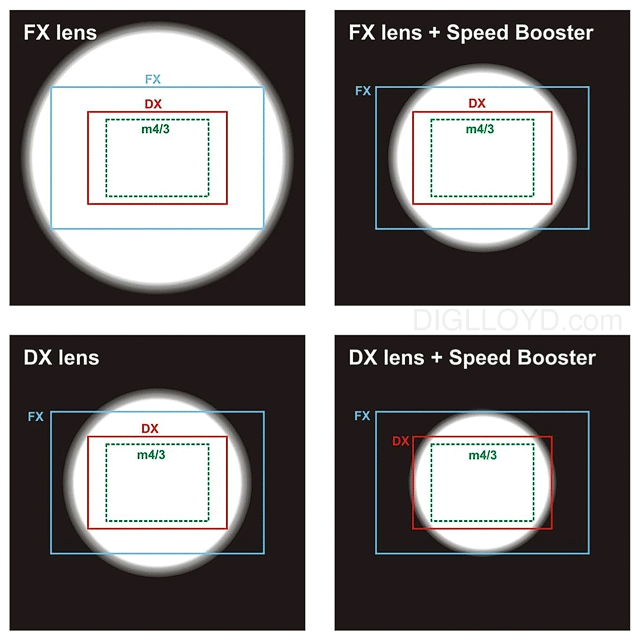Metabones and Caldwell Photographic introduce Speed Booster

I first heard this idea some time ago, but it is now a reality. Cool stuff!
The way this works is a short flange focal distance which allows the adapter to go in between the DSLR lens and the body. Cameras such as Sony NEX, Fuji X, and the Olympus E-M5 (MFT) work for this reason. But it will NOT work on any DSLR.
Read how the Speed Booster increases MTF.
Brian Caldwell of Coastal Optics 60/4 UV-VIS-IR APO-macro fame developed the optical portion of the Metabones Speed Booster.
Petersburg, VA, USA, January 14, 2013 - Metabones® and Caldwell Photographic jointly announce a revolutionary accessory called Speed Booster™, which mounts between a mirrorless camera and a SLR lens.
It increases maximum aperture by 1 stop (hence its name), increases MTF and has a focal length multiplier of 0.71x. For example, the Canon EF 85mm f/1.2L II lens becomes a 59mm f/0.9 lens on a Sony NEX camera, with increased sharpness. The faster F-stop allows for shallow depth-of-field and a lower ISO setting for decreased noise.
Speed Booster is also particularly pertinent to ultra-wide-angle SLR lenses. The combined focal length multiplier of Speed Booster and an APS-C mirrorless camera is approximately 1.09x, making the combination almost "full-frame". Full-frame ultra-wide-angle SLR lenses largely retain their angle-of-view on an APS-C mirrorless camera when Speed Booster is used.
The optics of Speed Booster is designed by Brian Caldwell, PhD, a veteran of highly-corrected lens designs such as the Coastal Optics 60mm f/4 UV-VIS-IR APO Macro lens with exemplary MTF performance (focusing done with visible light requires no correction whatsoever for the full spectrum from UV to IR).
Speed Booster serves double-duty as a lens mount adapter, from Canon EF lens (but not EF-S) to Sony NEX, with auto-aperture, image stabilization, EXIF and (slow) autofocus support for late-model (post-2006) Canon-brand lenses. It will be available in January 2013 from Metabones' web site and its worldwide dealer network for US$599 plus shipping and applicable taxes and duties.
Other mount combinations will follow shortly afterwards. Leica R, ALPA, Contarex, Contax C/Y and Nikon F (with aperture control for G lenses) will be supported, as will Micro 4/3 and Fuji X-mount cameras. Support for other mounts will be added in the future.
The Speed Booster approach makes a powerful argument for itself:
- Super-speed lenses on Micro Four Thirds, Sony NEX, Fuji X.
- Improved image definition (MTF).
- it moves the exit pupil further from the image plane for any objective lens, improving the telecentricity of the lens system. This helps to improve corner illumination and reduce sensor artifacts such as color variations caused by pixel crosstalk.
- A dirty little secret in digital photography is that the filter pack (low-pass filter + infrared filter + sensor cover glass) found in virtually all digital cameras can contribute significant aberration to the image when a lens designed for film is used. This problem is particularly troublesome for very fast lenses. The Speed Booster corrects this defect, and automatically corrects for filter pack aberrations regardless of the objective lens used.
On the image quality front, actual results remain to be seen; improving MTF is a huge bonus, but if the original lens is a modest performer to being with, then results can only improve so much. I’ll be testing the SpeedBooster to find out for myself. I am particularly interested in seeing what it can do with the Canon 40mm f/2.8 STM, which is already excellent on full frame

One thing I’m not clear on is whether the SpeedBooster will use increased reduction options for Micro Four Thirds (MFT), since the MFT sensor size is smaller. This would have a direct impact on lens speed and field of view. But from the example above, the 3:2 reduction implies that the same optics are used for APS-C as for MFT (which also makes possible the use of FX and DX optics with the same adapter). But this approach might actually be a good thing, since it will lose the outer areas which generally perform less well anyway, e.g. the area between the m4/3 and DX rectangle below.

The diagram below shows the original image that was intended for a full frame camera being reduced in size, and focusing closer. Cameras like Sony NEX, Fuji X and Micro Four Thirds make this possible: the SpeedBooster essentially occupies the gap between the two images (but in front of the camera).





























